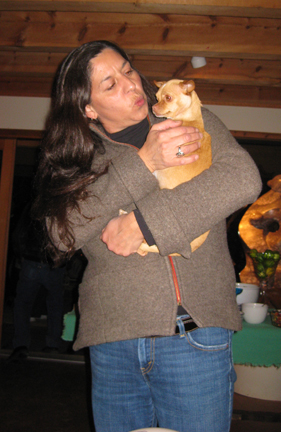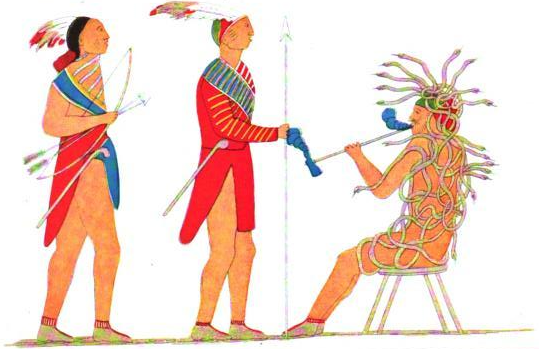|
Tree Of Peace
The Haudenosaunee Tree of Peace finds its roots in a man named Dekanawida, the peace-giver. The legends surrounding his place amongst the Iroquois (the Haudenosaunee) is based in his role in creating the Five Nations Confederacy, which consisted of the Mohawks, Oneidas, Onondagas, Cayugas, and Senecas, and his place as a cultural hero to the Haudenosaunee Nation, commonly known in Western culture as "Iroquois". The official title of the confederacy is, Kayanerenh-kowa (the Great Peace)Paul A. Wallace. " Dekanawida (The Heavenly Messenger) " Dictionary of Canadian Biography. Vol 1 (University of Toronto, Toronto, 1979) as described by Paul A. Wallace, "it is also known as Kanonsionni (the Long-House), a term that describes both its geographical extent and its constitutional form". The myths and legends surrounding Dekanawida have the roots in the oral histories that followed many Native American tribes throughout their histories. A political reality, with mythic proportions, ... [...More Info...] [...Related Items...] OR: [Wikipedia] [Google] [Baidu] |
Pinus Strobus Trees
A pine is any conifer tree or shrub in the genus ''Pinus'' () of the family Pinaceae. ''Pinus'' is the sole genus in the subfamily Pinoideae. ''World Flora Online'' accepts 134 species-rank taxa (119 species and 15 nothospecies) of pines as current, with additional synonyms, and ''Plants of the World Online'' 126 species-rank taxa (113 species and 13 nothospecies), making it the largest genus among the conifers. The highest species diversity of pines is found in Mexico. Pines are widely distributed in the Northern Hemisphere; they occupy large areas of boreal forest, but are found in many habitats, including the Mediterranean Basin, and dry tropical forests in southeast Asia and Central America. Wood from pine trees is one of the most extensively used types of timber, and some pines are widely used as Christmas trees. Description Pine trees are evergreen, coniferous resinous trees (or, rarely, shrubs) growing tall, with the majority of species reaching tall. The smallest ... [...More Info...] [...Related Items...] OR: [Wikipedia] [Google] [Baidu] |
Dekanawida
The Great Peacemaker ( ), sometimes referred to as Deganawida or Tekanawí:ta in Mohawk (as a mark of respect, some Iroquois avoid using his personal name except in special circumstances) was by tradition, along with Jigonhsasee and Hiawatha, the founder of the ''Haudenosaunee'', commonly called the Iroquois Confederacy. This is a political and cultural union of six Iroquoian-speaking Native American tribes governing parts of the present-day state of New York, northern Pennsylvania, and the eastern portion of the provinces of Ontario, and Quebec Canada, recognized as sovereign by both the USA and Canada. Background The Great Peacemaker's name means . Some of the numerous legends about the Great Peacemaker have conflicting information. It is reported that he was born a Huron, and by some accounts, his mother was a virgin, making the birth miraculous. Others say he was born an Onondaga and later adopted by the Mohawk. Arthur C. Parker's book ''The Constitution of the Five N ... [...More Info...] [...Related Items...] OR: [Wikipedia] [Google] [Baidu] |
Iroquois
The Iroquois ( ), also known as the Five Nations, and later as the Six Nations from 1722 onwards; alternatively referred to by the Endonym and exonym, endonym Haudenosaunee ( ; ) are an Iroquoian languages, Iroquoian-speaking Confederation#Indigenous confederations in North America, confederacy of Native Americans in the United States, Native Americans and First Nations in Canada, First Nations peoples in northeast North America. They were known by the French during the Colonial history of the United States, colonial years as the Iroquois League, and later as the Iroquois Confederacy, while the English simply called them the "Five Nations". Their country has been called wikt:Iroquoia, Iroquoia and Haudenosauneega in English, and '':fr:Iroquoisie, Iroquoisie'' in French. The peoples of the Iroquois included (from east to west) the Mohawk people, Mohawk, Oneida people, Oneida, Onondaga people, Onondaga, Cayuga people, Cayuga, and Seneca people, Seneca. After 1722, the Iroquoian-sp ... [...More Info...] [...Related Items...] OR: [Wikipedia] [Google] [Baidu] |
Mohawk People
The Mohawk, also known by their own name, (), are an Indigenous peoples of the Americas, Indigenous people of North America and the easternmost nation of the Haudenosaunee, or Iroquois Confederacy (also known as the Five Nations or later the Six Nations). Mohawk are an Iroquoian languages, Iroquoian-speaking people with communities in southeastern Canada and northern New York (state), New York State, primarily around Lake Ontario and the St. Lawrence River. As one of the five original members of the Iroquois Confederacy, the Mohawk are known as the Keepers of the Eastern Door who are the guardians of the confederation against invasions from the east. Today, Mohawk people belong to the Mohawk Council of Akwesasne, Mohawks of the Bay of Quinte First Nation, Mohawks of Kahnawà:ke, Mohawks of Kanesatake, Six Nations of the Grand River, and Saint Regis Mohawk Tribe, a federally recognized tribe in the United States. At the time of European contact, Mohawk people were based in th ... [...More Info...] [...Related Items...] OR: [Wikipedia] [Google] [Baidu] |
Oneida People
The Oneida people ( ; wikt:autonym, autonym: Onʌyoteˀa·ká·, Onyota'a:ka, ''the People of the Upright Stone, or standing stone'', ''Thwahrù·nęʼ'' in Tuscarora language, Tuscarora) are a Native Americans in the United States, Native American tribe and First Nations in Canada, First Nations band government, band. They are one of the five founding nations of the Iroquois, Iroquois Confederacy in the area of upstate New York, particularly near the Great Lakes. Originally the Oneida lived in what is now central New York (state), New York, particularly around Oneida Lake and Oneida County, New York, Oneida County. Today the Oneida have four federally recognized nations: the Oneida Indian Nation in New York, the Oneida Nation in and around Green Bay, Wisconsin, in the United States; and two in Ontario, Canada: Oneida at Six Nations of the Grand River, and Oneida Nation of the Thames in Southwold, Ontario, Southwold. People of the Standing Stone The name Oneida is derived from ... [...More Info...] [...Related Items...] OR: [Wikipedia] [Google] [Baidu] |
Onondaga People
The Onondaga people (Onontaerrhonon, Onondaga language, Onondaga: , "People of the Hills") are one of the five original nations of the Iroquois, Haudenosaunee (Iroquois) Confederacy in the Northeastern Woodlands. Their historical homelands are in and around present-day Onondaga County, New York, south of Lake Ontario. Being centrally located, they are considered the "Keepers of the Fire" ( in Tuscarora language, Tuscarora) in the figurative longhouse that shelters the Five Nations. The Cayuga tribe, Cayuga and Seneca tribe, Seneca have territory to their west and the Oneida tribe, Oneida and Mohawk nation, Mohawk to their east. For this reason, the League of the Iroquois historically met at the Iroquois government's capital at Onondaga (village), Onondaga, as the traditional chiefs do today. In the United States, the home of the Onondaga Nation is the Onondaga Reservation. Onondaga people also live near Brantford, Ontario on Six Nations of the Grand River, Six Nations territory. ... [...More Info...] [...Related Items...] OR: [Wikipedia] [Google] [Baidu] |
Cayuga People
The Cayuga ( Cayuga: Gayogo̱hó꞉nǫʼ, "People of the Great Swamp") are one of the five original constituents of the Haudenosaunee (Iroquois), a confederacy of Native Americans in New York. The Cayuga homeland lies in the Finger Lakes region along Cayuga Lake, between their league neighbors, the Onondaga to the east and the Seneca to the west. Today, Cayuga people belong to the Six Nations of the Grand River First Nation in Ontario, and the federally recognized Cayuga Nation of New York and the Seneca-Cayuga Tribe of Oklahoma. History Political relations between the Cayuga, the British, and the Thirteen Colonies during the American Revolution were complicated and variable, with Cayuga warriors fighting on both sides (as well as abstaining from war entirely). Most of the Iroquois nations allied with the British, in part hoping to end encroachment on their lands by colonists. In 1778, various Iroquois bands, oft allied with British-colonial loyalists ( Tories) cond ... [...More Info...] [...Related Items...] OR: [Wikipedia] [Google] [Baidu] |
Seneca People
The Seneca ( ; ) are a group of Indigenous Iroquoian-speaking people who historically lived south of Lake Ontario, one of the five Great Lakes in North America. Their nation was the farthest to the west within the Six Nations or Iroquois League ( Haudenosaunee) in New York before the American Revolution. For this reason, they are called “The Keepers of the Western Door.” In the 21st century, more than 10,000 Seneca live in the United States, which has three federally recognized Seneca tribes. Two of them are centered in New York: the Seneca Nation of Indians, with five territories in western New York near Buffalo; and the Tonawanda Seneca Nation. The Seneca-Cayuga Nation is in Oklahoma, where their ancestors were relocated from Ohio during the Indian Removal. Approximately 1,000 Seneca live in Canada, near Brantford, Ontario, at the Six Nations of the Grand River First Nation. They are descendants of Seneca who resettled there after the American Revolution, as they ... [...More Info...] [...Related Items...] OR: [Wikipedia] [Google] [Baidu] |
White Pine
''Pinus'', the pines, is a genus of approximately 111 extant tree and shrub species. The genus is currently split into two subgenera: subgenus ''Pinus'' (hard pines), and subgenus ''Strobus'' (soft pines). Each of the subgenera have been further divided into sections based on chloroplast DNA sequencing and whole plastid genomic analysis. Older classifications split the genus into three subgenera – subgenus ''Pinus'', subgenus ''Strobus'', and subgenus ''Ducampopinus'' ( pinyon, bristlecone and lacebark pines) – based on cone, seed and leaf characteristics. DNA phylogeny has shown that species formerly in subgenus ''Ducampopinus'' are members of subgenus ''Strobus'', so ''Ducampopinus'' is no longer used. The species of subgenus ''Ducampopinus'' were regarded as intermediate between the other two subgenera. In the modern classification, they are placed into subgenus ''Strobus'', yet they did not fit entirely well in either so they were classified in a third subgenu ... [...More Info...] [...Related Items...] OR: [Wikipedia] [Google] [Baidu] |
Great Law Of Peace
Among the Haudenosaunee (the "Six Nations," comprising the Mohawk, Onondaga, Oneida, Cayuga, Seneca, and Tuscarora peoples) the Great Law of Peace ( Mohawk: ''Kaianere’kó:wa''), also known as Gayanashagowa, is the oral constitution of the Iroquois Confederacy. The law was represented by symbols on wampum belts which functioned as mnemonic devices for storytellers, conceived by Dekanawidah, known as the Great Peacemaker, and his spokesman Hiawatha. The original five member nations ratified this constitution near modern-day Victor, New York, with the sixth nation (the Tuscarora) being added in 1722. The laws were first recorded and transmitted by means of wampum, shell-bead belts that encoded the message in a sequence of pictograms. In the 19th century it was translated into English and other languages. The Great Law of Peace is presented as part of a narrative noting laws and ceremonies to be performed at prescribed times. The laws, called a constitution, are divid ... [...More Info...] [...Related Items...] OR: [Wikipedia] [Google] [Baidu] |
Iroquois Culture
The Iroquois ( ), also known as the Five Nations, and later as the Six Nations from 1722 onwards; alternatively referred to by the Endonym and exonym, endonym Haudenosaunee ( ; ) are an Iroquoian languages, Iroquoian-speaking Confederation#Indigenous confederations in North America, confederacy of Native Americans in the United States, Native Americans and First Nations in Canada, First Nations peoples in northeast North America. They were known by the French during the Colonial history of the United States, colonial years as the Iroquois League, and later as the Iroquois Confederacy, while the English simply called them the "Five Nations". Their country has been called wikt:Iroquoia, Iroquoia and Haudenosauneega in English, and '':fr:Iroquoisie, Iroquoisie'' in French. The peoples of the Iroquois included (from east to west) the Mohawk people, Mohawk, Oneida people, Oneida, Onondaga people, Onondaga, Cayuga people, Cayuga, and Seneca people, Seneca. After 1722, the Iroquoian-sp ... [...More Info...] [...Related Items...] OR: [Wikipedia] [Google] [Baidu] |






